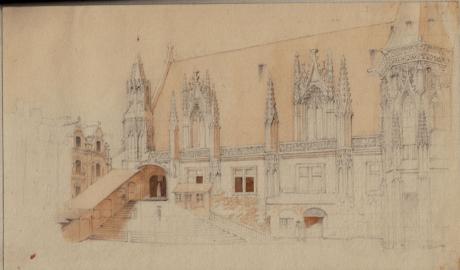Yet another masterpiece of the flamboyant Gothic style which has been so popular in Rouen's history it seems, the Palais de Justice (Law Courts) was little more than a bombed out shell at the end of the second world war. Since then the building has been painstakingly restored (save a few bullet holes and scars of shell damage on the facade facing onto Rue Jeanne d'Arc) to it's ultimate glory. The law courts are a mixed Flamboyant Gothic and Renaissance style (early 16C). There is a central section and two wings. There was heavy bomb damage in 1940 and what we see is much restored. (The craters disclosed that the building was built over underlying Hebrew synagogue and Jewish residences). The lower parts of the building is severe but the roofline is studded with pinnacled buttresses and decorated gables and along the street side a flock of gargoyles. Note the fine doorway. We were not able to see the fine restored interiors but they are worth a view as they have a vivid history.
Boys was born at Pentonville, London, on 2 January 1803. He was articled to the engraver George Cooke. When his apprenticeship came to an end he went to Paris where he met and came under the influence of Richard Parkes Bonington, who persuaded him to abandon engraving for painting. Some sources describe him as a pupil of Bonington, although William Callow, who later shared a studio with him in Paris, disputed this.
He exhibited at the Royal Academy for the first time in 1824, and in Paris in 1827. In 1830 he went to Brussels, but returned to England on the outbreak of the revolution there. Paying another visit to Paris, he remained there until 1837, and then returned to England in order to lithograph the works of David Roberts and Clarkson Stanfield.
His most important work, Picturesque Architecture in Paris, Ghent, Antwerp, Rouen, etc., a collection of colour lithographs, appeared in 1839, attracting a great deal of admiration.Drawn on the stone by Boys and printed by Charles Joseph Hullmandel, it was described in a review in the Polytechnic Journal as "the first successful effort in chroma-lithography hitherto brought to perfection". King Louis-Philippe sent the artist a ring in recognition of its merits. He also published Original Views of London as it is, drawn and lithographed by himself, (London, 1843). He drew the illustrations to Blackie's History of England, and etched some plates for John Ruskin's Stones of Venice.
Boys was a member of the Institute of Painters in Water Colours, and of several foreign artistic societies. He died in 1874.

